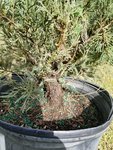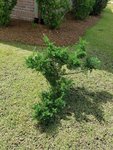bsdlain
Seed
I was able to get this Junper Parsonii this afternoon. It has an incredibly thick trunk, and a nice natural shape -- though a little big. I have it sitting in the sun, the nursery had it in partial sun and the leaves were a little yellow. It's the middle of summer, so I don't want to repot, but I honestly don't know anything about this type of Juniper. I'm tempted to just let it grow into the spring, but I want to be sure. My questions are:
1. Should I slip pot it? The root ball feels tight, I tried to tug a bit at the tree, and dig my finger into the soil and it just felt really hard.
2. Should I put it in a basket, like a mesh pot?
3. Should I start the wire process, or wait until next year?
4. Should I trim?
If someone needs better pictures let me know. I'm zone 7.
Thank you!
1. Should I slip pot it? The root ball feels tight, I tried to tug a bit at the tree, and dig my finger into the soil and it just felt really hard.
2. Should I put it in a basket, like a mesh pot?
3. Should I start the wire process, or wait until next year?
4. Should I trim?
If someone needs better pictures let me know. I'm zone 7.
Thank you!



